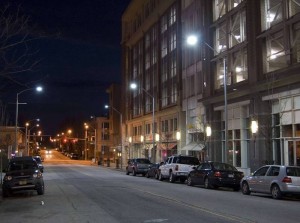We’ve been writing a lot about how utilities are pushing back against rising amounts of renewable energy because it’s gotten to the point where their business model is threatened – now we hear that lighting efficiency is also a problem for them.
Some of the biggest cities in the US, such as New York, Los Angeles and Boston are – or already have – switched to LED lights, which means they won’t burn out for some 20 years. It turns out that could put a big dent in utility profits for a couple of reasons.
The obvious reason is that because LEDs are so much more efficient than traditional street lights that utilities will earn much less revenue for the energy they use.
Another reason has to do with who owns and services the 35 million street lights in the US. We assumed that towns and cities own them, but it turns out that’s not always the case.
Most cities pay their utility a flat, monthly fee for every street light, which includes the light itself, maintenance, and electricity, reports The Energy Collective. "Therein lies the rub—regulated utilities often have little incentive to invest in more efficient streetlights, which offer a reliable, consistent, and often lucrative revenue stream that comes at a time of day (or night) when demand is low," they say.
Authors of the Energy Collective article, Dan Cross-Call and Dan Howe explain:
"Despite a seeming incentive for utilities to invest in efficiency and thus increase the profit margin between the flat monthly rate they charge municipalities and the kilowatt-hours that are bundled in that rate, installing a more efficient street lighting system typically requires approval from the state PUC, including tariff updates to reflect the new costs—a process that would erode any cost savings the utility would hope to capture."
Since street lights are often the single biggest energy cost for cities, with taxpayers paying millions of dollars each year, they are motivated to change this sistuation. Many cities are looking at new models like performance contracting and privatization and some are issuing bonds to buy the systems outright.
Although it is quite expensive for a city-wide retrofit, the payback period is short. Los Angeles, which replaced all 141,000 bulbs with LEDs, expects annual savings of $7 million for energy and $2.5 million on maintenance (changing the bulbs).

LEDs also have the potential of being combined with sensors and software intelligence, giving them the ability to monitor traffic flow, remotely get brighter or dimmer in support of first responders during an emergency, read utility meters from nearby houses, serve as Wi-Fi hot spots, and more, say Cross-Call and Howe.
Read the full article:

In fact,the led lighting now can not use about 20 years, even 10 years. Because the elements of driver can not last such long. So we need to use the good material and elements to make sure the led lamps can be used as long as we expecting.
dreamerlighting com
Where did the 35 million streetlights figure come from? Can you point me to that source please.
Lower electricity usage means that utilities wont have to build as many new power plants so there is incentive for them to want cities to switch to LED’s.